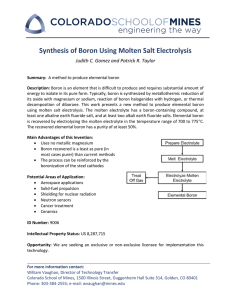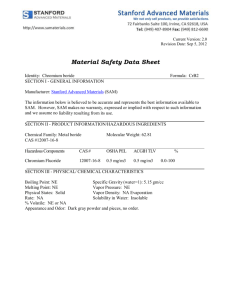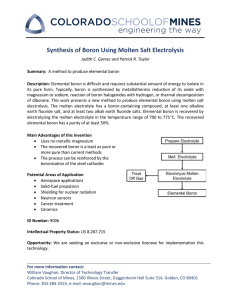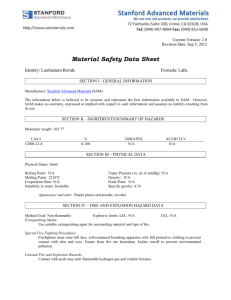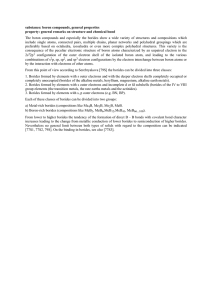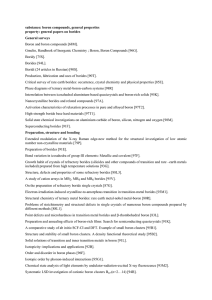SEVENTH INTERNATIONAL SYMPOSIUM ON
advertisement
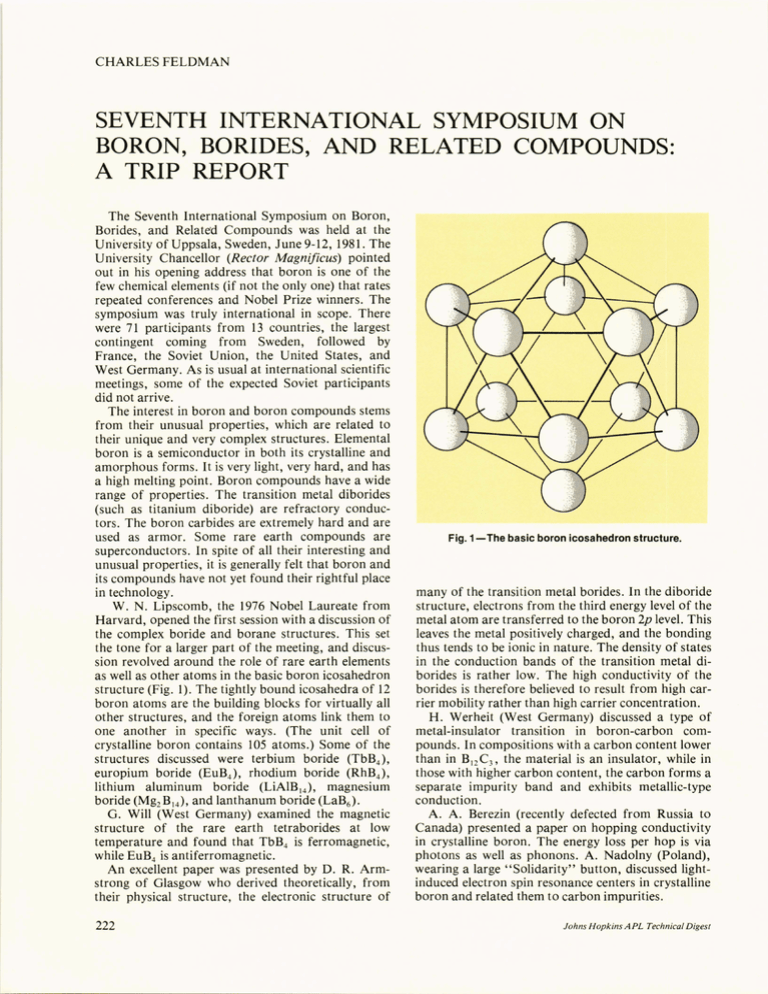
CHARLES FELDMAN SEVENTH INTERNATIONAL SYMPOSIUM ON BORON, BORIDES, AND RELATED COMPOUNDS: A TRIP REPORT The Seventh International Symposium on Boron, Borides, and Related Compounds was held at the University of Uppsala, Sweden, June 9-12, 1981. The University Chancellor (Rector Magnijicus) pointed out in his opening address that boron is one of the few chemical elements (if not the only one) that rates repeated conferences and Nobel Prize winners. The symposium was truly international in scope. There were 71 participants from 13 countries, the largest contingent coming from Sweden, followed by France, the Soviet Union, the United States, and West Germany. As is usual at international scientific meetings, some of the expected Soviet participants did not arrive. The interest in boron and boron compounds stems from their unusual properties, which are related to their unique and very complex structures. Elemental boron is a semiconductor in both its crystalline and amorphous forms. It is very light, very hard, and has a high melting point. Boron compounds have a wide range of properties. The transition metal diborides (such as titanium diboride) are refractory conductors. The boron carbides are extremely hard and are used as armor. Some rare earth compounds are superconductors. In spite of all their interesting and unusual properties , it is generally felt that boron and its compounds have not yet found their rightful place in technology. W. N. Lipscomb, the 1976 Nobel Laureate from Harvard, opened the first session with a discussion of the complex boride and borane structures. This set the tone for a larger part of the meeting, and discussion revolved around the role of rare earth elements as well as other atoms in the basic boron icosahedron structure (Fig. 1). The tightly bound icosahedra of 12 boron atoms are the building blocks for virtually all other structures, and the foreign atoms link them to one another in specific ways. (The unit cell of crystalline boron contains 105 atoms.) Some of the structures discussed were terbium boride (TbB 4 ), europium boride (EuB 4 ), rhodium boride (RhB 4 ), lithium aluminum boride (LiAlB ,4), magnesium boride (Mg 2 B I4 ), and lanthanum boride (LaB6). G. Will (West Germany) examined the magnetic structure of the rare earth tetraborides at low temperature and found that TbB 4 is ferromagnetic, while EuB 4 is antiferromagnetic. An excellent paper was presented by D. R. Armstrong of Glasgow who derived theoretically, from their physical structure, the electronic structure of 222 Fig. 1-The basic boron icosahedron structure. many of the transition metal borides. In the diborlde structure, electrons from the third energy level of the metal atom are transferred to the boron 2p level. This leaves the metal positively charged, and the bonding thus tends to be ionic in nature. The density of states in the conduction bands of the transition metal diborides is rather low. The high conductivity of the borides is therefore believed to result from high carrier mobility rather than high carrier concentration. H. Werheit (West Germany) discussed a type of metal-insulator transition in boron-carbon compounds. In compositions with a carbon content lower than in B 12 C 3 , the material is an insulator, while in those with higher carbon content, the carbon forms a separate impurity band and exhibits metallic-type conduction. A. A. Berezin (recently defected from Russia to Canada) presented a paper on hopping conductivity in crystalline boron. The energy loss per hop is via photons as well as phonons. A. Nadolny (Poland), wearing a large "Solidarity" button, discussed lightinduced electron spin resonance centers in crystalline boron and related them to carbon impurities. Johns H opkins A PL Technical Digest I presented a paper entitled "The Behavior of TiB2 Thin Film Electrodes in Polycrystalline Silicon Thin Film Solar Cells," coauthored by APL scientists F. G. Satkiewicz and N. A. Blum. The paper discussed the high-temperature (l200°C) interactions of TiB2 layers with Al 20 3 substrates and with silicon films. The silicon layers were deposited on top of the TiB2 layers; both layers form part of a solar cell structure being developed at APL. The audience was interested in our techniques for examjning the reactiqns taking place at the interfaces. They were also happy to see a novel application for a boride. Several papers were presented on the formation of n-type crystalline boron. This is of interest because the doping of semiconducting boron to change its conductivity from p- to n-type had been considered difficult. When iron is placed in crystalline boron, it apparently can occupy interstitial positions and produce n-type free carriers. Another paper pointed out that the n-type material could be formed with either iron, cobalt, or nickel, also in the interstitial position, but they found that the compounds were n-type at low temperature (- 300°C) and p-type at high temperature. The amount of doping required to form n-type boron was about 30/0, which is very high compared to that required for silicon or germanium. An interesting paper on superconductivity in Volume 2, N umber 3, 1981 metal-rhodium-boron compounds was given by M. J. Sienko of Cornell University. Erbium (Er) in the compound ErRh4B4 was replaced by mixtures of yttrium (Y), lutetium (Lu) , and thorium (Th), forming complex compounds such as Y0.09 Th o.08 Rh4B4. With various mixtures, critical temperatures could be changed from 4.8 to 10.01 K. I discussed with Sienko the reported news of superconductivity in titanium diboride and we agreed that it was perhaps a case of overexuberant reporting. Most of the Russian participants were assigned to Poster Sessions. Russian work in boron and borides is extensive. Experiments are in progress on forming hard boride coatings on carbide alloys and steels, the interaction of titanium and boride, the crystallization of boron and borides, boron filaments, etc. I was given a place of honor at the banquet table, having had the distinction of being the only participant present who had also attended the first conference at Fort Monmouth, N. J., in 1959. The Swedish hosts were most cordial throughout the conference. The complete proceedings of the symposium will be issued in early 1982. The next conference, in 1984, is to be held in (or near) Tbilesi, U.S.S.R. In addition to borides, the conference topics will include nitrides and carbides. 223

